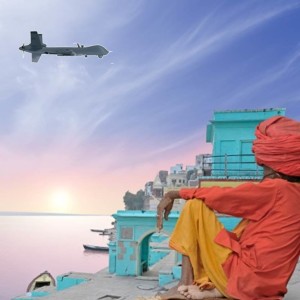 The efficacy of unmanned aircraft systems (UAS) as an early warning mechanism against enemy sneaking in aboard hijacked or rogue vessels was demonstrated during Exercise Gemini-2, the second edition of integrated coastal defence drill for Kerala and Lakshadweep in India.
The efficacy of unmanned aircraft systems (UAS) as an early warning mechanism against enemy sneaking in aboard hijacked or rogue vessels was demonstrated during Exercise Gemini-2, the second edition of integrated coastal defence drill for Kerala and Lakshadweep in India.
The Heron and Searcher UAS of the Navy’s air squadron No. 342 based at the Southern Naval Command in Kochi took to the skies relentlessly, picking out at least a few suspect vessels on each flight and alerting the defence forces to the threat.
“They proved quite useful in searching for rogue boats, which made it easy for us to instruct interceptor boats on patrol to check them out,” said a Navy officer. “Given the flight safety restrictions imposed by commercial aviation, they couldn’t be flown at high altitudes. But they did a good job,” he said.
 While the highs and lows of the drill, conducted periodically to review security mechanism, can only be found out after a thorough debriefing, Gemini-2 showcased the near-impenetrability of the region’s coastal security armour, characterised by a robust network of static coastal sensors, surveillance data relayed by the UAS and Dornier maritime recce aircraft, helicopters on watch, Navy, Coast Guard and Marine police parties on patrol and members of the Kadalora Jagrata Samithi (a collective of fishermen acting as the eyes and ears of security agencies).
While the highs and lows of the drill, conducted periodically to review security mechanism, can only be found out after a thorough debriefing, Gemini-2 showcased the near-impenetrability of the region’s coastal security armour, characterised by a robust network of static coastal sensors, surveillance data relayed by the UAS and Dornier maritime recce aircraft, helicopters on watch, Navy, Coast Guard and Marine police parties on patrol and members of the Kadalora Jagrata Samithi (a collective of fishermen acting as the eyes and ears of security agencies).
Coastal security stakeholders pooled in their resources to play out a simulated security scenario during the exercise. While enemy teams launched from hijacked mother ships were tasked with carrying out improvised assaults on designated targets (which were not disclosed to the policing forces), the defence forces, to their credit, were able to neutralise all attacks barring two in Thiruvananthapuram.
The assailants were successful in making their way into the railway station at Thampanoor and the passenger terminals of the international airport.
Heightened alert at vital installations — including Vikram Sarabhai Space Centre (VSSC); National Thermal Power Corporation (NTPC), Kayamkulam; International Container Transshipment Terminal (ICTT) at Vallarpadam; and the single point mooring by BPCL off Kochi — made it impossible for the attackers to reach anywhere close.
The assailants were asked to use their ingenuity in launching attacks at crowded places like some shopping malls in Kochi, tourist spots, and sensitive establishments. But the protective forces used a mix of coastal patrol and on-shore combing to thwart them. Inland waters were to be used by the attacking teams, but none could do that, said an official.
The massive exercise saw the Coastal Police alone mobilise 17 boats for patrolling. In all, nearly 100 vessels, including those of the Navy, Coast Guard, Marine Enforcement Wing, and Customs besides fishing vessels, were part of the patrol.
Security of the Lakshadweep archipelago proved to be the toughest for the inimical forces to crack, said an official.
Coast Guard stations at Kavaratti and Fort Kochi coordinated the exercise in their respective regions, while the Joint Operations Centre at the Naval Base oversaw the overall proceedings.
Source: The Hindu
